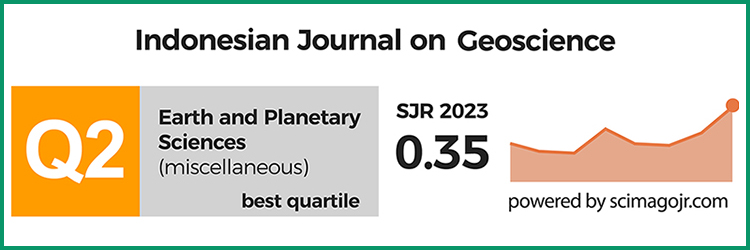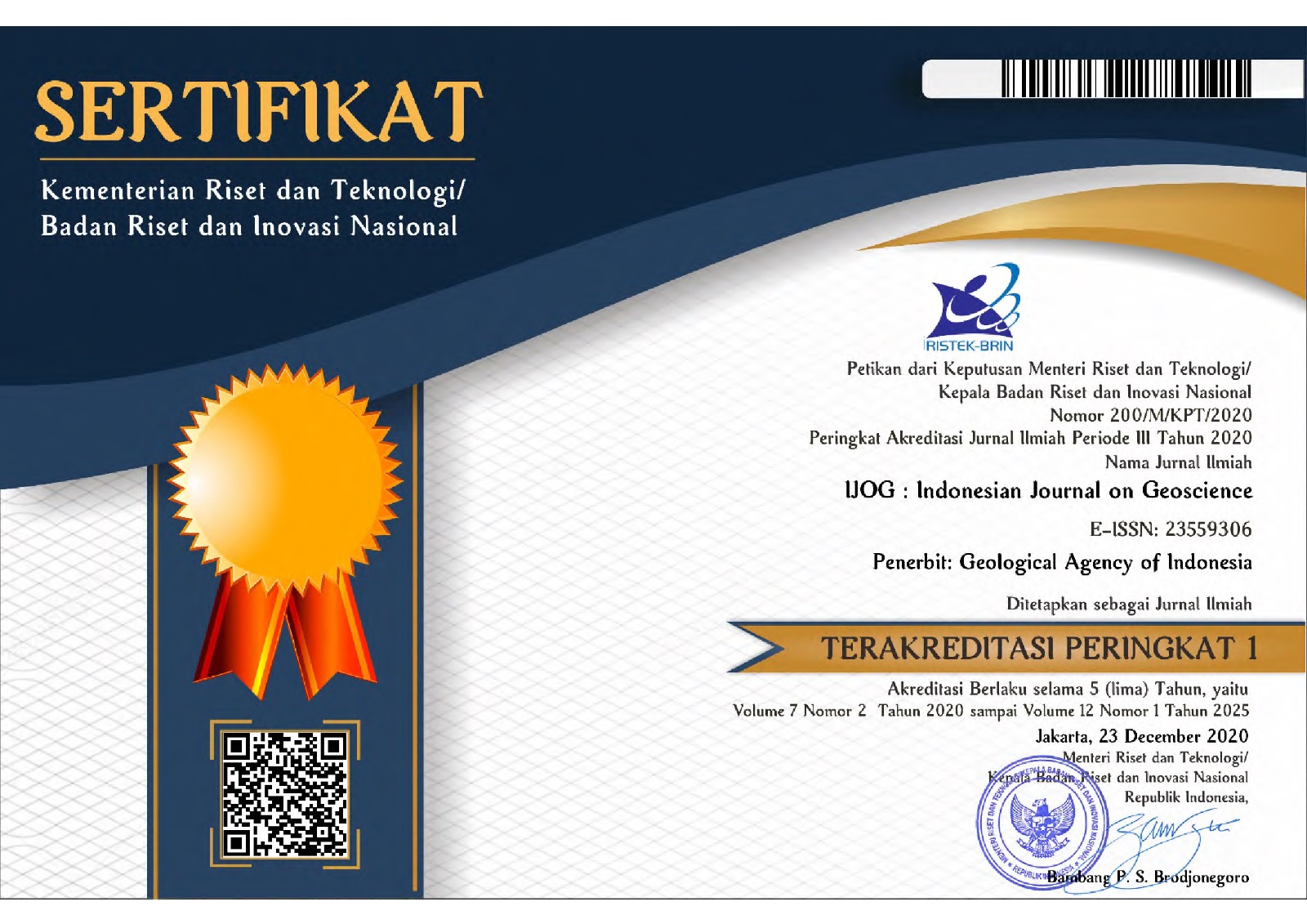Site Specific Ground Response Analysis for Quantifying Site Amplification at A Regolith Site
DOI:
https://doi.org/10.17014/ijog.4.3.159-167Keywords:
site response analysis, regolith, site amplification, AdelaideAbstract
DOI: 10.17014/ijog.4.3.159-167
A numerical model has demonstrated that it can simulate reasonably well earthquake motions at the ground level during a seismic event. The most widely used model is an equivalent linear approach. The equivalent linear model was used to compute the free-field response of Adelaide regolith during the 1997 Burra earthquake. The aim of this study is to quantify the amplification at the investigated site. The model computed the ground response of horizontally layered soil deposits subjected to transient and vertically propagating shear waves through a one-dimensional-soil column. Each soil layer was assumed to be homogeneous, visco-elastic, and infinite in the horizontal extent. The results of this study were compared to other studies and forward computation of the geotechnical dynamic parameters of the investigated site. The amplification triggered by the 1997 Burra seismic event was deduced. This study reveals the amplification factor up to 3.6 at the studied site.
References
Bardet, J., Ichii, K., and Lin, C., 2000. EERA a computer program for Equivalent-linear Earthquake site Response Analyses of layered soil deposits. Department of Civil Engineering, University of Southern California.
Collins, C., Kayen, R., Carkin, B., Allen, T., Cummins, P., and McPherson, A., 2006. Shear wave velocity measurement at Australian ground motion seismometer sites by the spectral analysis of surface waves (SASW) method. Earthquake Engineering in Australia.
DMITRE Minerals (Department of Manufacturing, Innovation, Trade, Resources and Energy Official Website), 2013. Urban Monitoring. https://www.pir.sa.gov.au/minerals/earthquakes/urban_monitoring [2 November 2013].
Dickenson, S., Seed, R., Lysmer, J., and Mok, C., 1991. Response of Soft Soils during the 1989 Lorna Prieta Earthquake and Implications for Seismic Design Criteria. Proceedings of Pacific Conference on Earthquake Engineering, Auckland, New Zealand.
Eggleton, R., A., 2001. The regolith glossary (surficial geology, soils and lanscapes). Coperative Research Centre for Landscape Evolution and Mineral Exploration, ISBN 0-7315-3343-7, 144pp.
García-Jerez, A., Piña-Flores, J., Sánchez-Sesma, F. J., Luzón, F., and Perton, M., 2016. A computer code for forward computation and inversion of the HVSR spectral ratio under the diffuse field assumption. Computers & Geosciences, 97, p.67-78. DOI:10.1016/j.cageo.2016.06.016
Herak, M., 2008. ModelHVSR-a Matlab tool to model horizontal-to-vertical spectral ratio of ambient noise. Computers & Geosciences, 34, p.1514-1526. DOI:10.16/j.cageo.2007.07.009.
Idriss, I., 1990. Response of Soft Soil Sites during Earthquakes. Proceedings of Memorial Symposium to honor Professor Harry Bolton Seed, II, Berkeley, California.
Idriss, I., 1991. Earthquake Ground Motions at Soft Soil Sites. Proceedings of Second International Conference on Recent Advances in Geotechnical Earthquake Engineering and Soil Dynamics, III, St. Louis: Missouri.
Love, D., 1996. Seismic hazard and microzonation of the Adelaide metropolitan area. Adelaide: Sutton Earthquake Centre, Department of Mines and Energy, South Australia.
Mitchell, P., 2009. Two aspects of liquefaction-Pile design and assessment difficulties. Seminar on Seismology and Earthquake Engineering.
Mitchell, P. and Moore, C., 2007. Difficulties in assessing liquefaction potential from conventional field testing. The Australian Earthquake Engineering Society Conferences.
NCST (Australian National Committee on Soil and Terrain), 2009. Australian soil and land survey field handbook. Australian Soil and Land Survey Handbook, Series; No. 1, 3rd ed. CSIRO Publishing, Collingwood, Victoria.
Poulos, H., Love, D., and Grounds, R., 1996. Seismic zonation of the Adelaide area. 7th Australia New Zealand Conference on Geomechanics.
Rollins, K., Hryciw, R., McHood, M., Homolka, M., and Shewbridge, S., 1992. Soil Amplification at Treasure Island during the Lorna Prieta Earthquake. NEHRP Report to Congress on the Loma Prieta Earthquake.
Schnabel, P., Lysmer, J., and Seed, H., 1972. A computer program for earthquake response analysis of horizontally layered sites, Earthquake Engineering Research Center (EERC), Report 72-12, Berkeley, California: University of California.
Seed, H.B. and Idriss, I.M., 1970. Soil moduli and damping factors for dynamic response analyses. Earthquake Engineering Research Center, Report No. EERC 70-10, University of California, Berkeley, California.
Seed, H.B. and Sun, J.H., 1989. Implication of site effects in the Mexico City earthquake of September 19, 1985 for earthquake - resistance - design criteria in the San Francisco Bay Area of California. Report No. UCB/EERC-89/03, University of California, Berkeley, California.
Selby, J. and Lindsay, J. 1982. Engineering geology of the Adelaide City area. Department of Mines and Energy, Geological Survey of South Australia, D. J. Woolman, Government Printer, Bulletin, 51.
Selby, J., 1984. Geology and the Adelaide Environment. Department of Mines and Energy, South Australia.
Setiawan, B., Jaksa, M., Griffith, M., and Love, D., 2016. Analysis of microtremor array measurement using the spatial autocorrelation (SPAC) method across the Adelaide City. Research Report No. 196, School of Civil, Environmental, and Mining Engineering, the University of Adelaide, 36pp.
Sheard, M. and Bowman, G., 1996. Soils, stratigraphy and engineering geology of near surface materials of the Adelaide Plains. Adelaide: Department of Mines and Energy, South Australia.
Somerville, P. and Graves, R., 1996. Site effects in the Los Angeles area during the 1994 Northridge earthquake. Eleventh World Conference on Earthquake Engineering, Paper No. 2030.
Wilford, J. and Thomas, M., 2013. Predicting regolith thickness in the complex weathering setting of the central Mt Lofty Ranges, South Australia. Geoderma, DOI:10.1016/j.geoderma.2013.04.002
Yokel, F., 1992. Effects of Subsurface Conditions on earthquake Ground Motions. Report No. NISTIR 4769, Building and Fire Research Laboratory, National Institute of Standards and Technology, Gaithersburg, Maryland, 85pp.



















